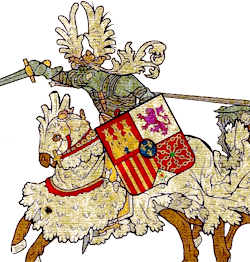.png?v=n9-g3GHVxRGQLS6PHRBvKggthZCPI04W1Ghmn3BZ-g4)
The zenith of medieval heraldry was in the 14th and 15th
centuries. This coincided with several major changes in medieval
society, such as the Hundred Years War between France and
England, the Wars of the Roses in England, the papal schism of
the Latin Church, and the Black Death.
These events introduced great movement of populations and
between the classes, creating a desire to map one's heritage and
anxiety to preserve what one already had.
It also coincided with developments in military technology that
required a system of quick and easy identification from a
distance.
The wars affected heraldic symbology. King Edward III, whose claim to the throne of France through his mother sparked the Hundred Years War, took the French royal fleur de lis on his shield to show that claim. 9 It remained in the royal English arms until 1801. 10 The competing houses of York and Lancaster took, as their badges, white and red roses respectively. However, roses did not appear directly in the shields of their coats of arms. 11
